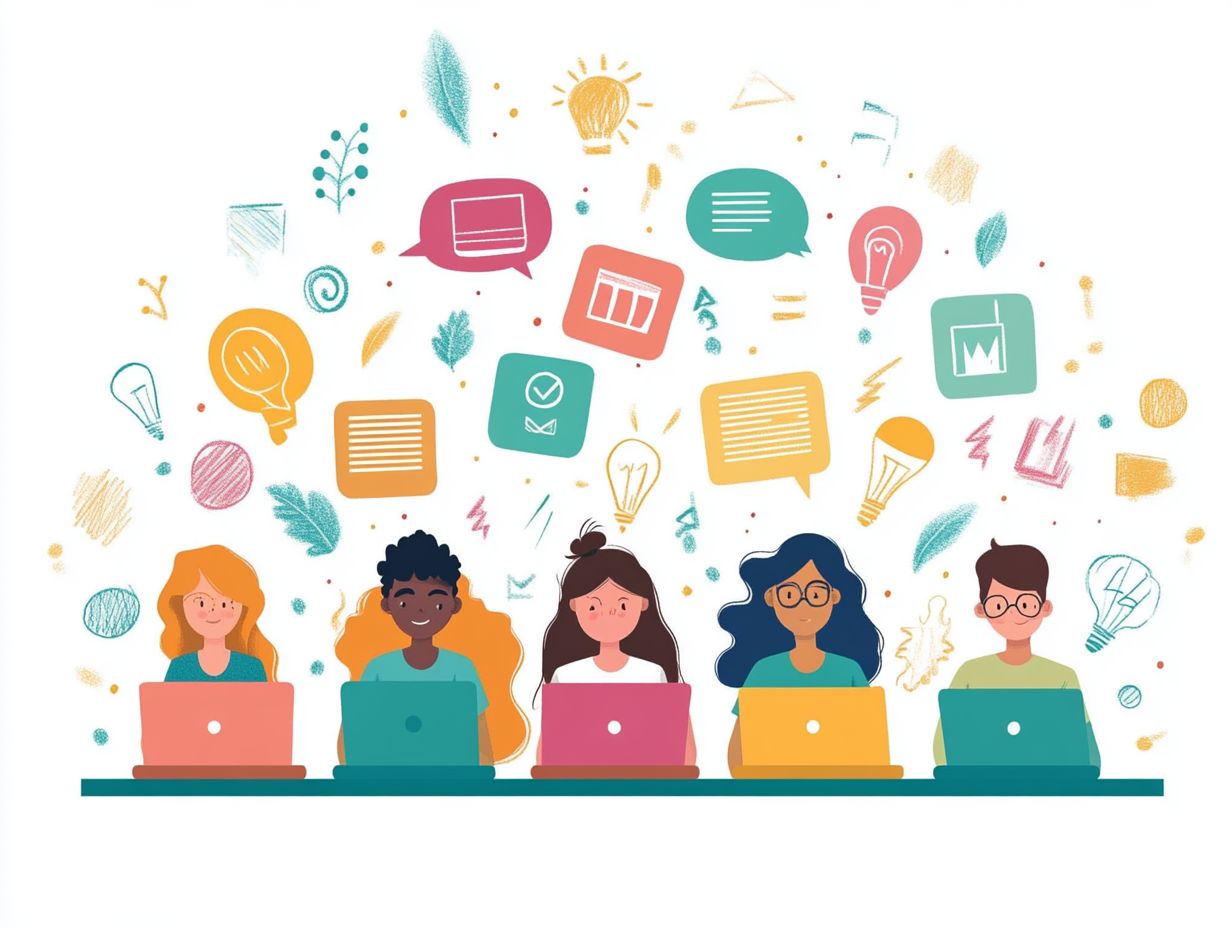5 Key Elements of Effective E-Learning
E-learning is changing how we learn new skills and gain knowledge. It s an exciting time to dive into online education!
This article explores five vital components: engaging content, a user-friendly platform, clear learning objectives, effective assessment methods, and regular feedback. Each element is crucial in crafting a comprehensive learning experience.
Explore best practices and insights that can elevate your e-learning journey to new heights.
Contents
- Key Takeaways:
- 1. Engaging and Interactive Content
- 2. User-Friendly Platform
- 3. Clear Learning Objectives and Outcomes
- 4. Effective Assessment Methods
- 5. Regular Feedback and Support
- What Is E-Learning and Why Is It Important?
- How Can Engaging and Interactive Content Be Achieved?
- What Features Make a Platform User-Friendly?
- How Can Learning Objectives and Outcomes Be Clearly Communicated?
- What Are the Different Types of Assessment Methods in E-Learning?
- What Are the Best Practices for Providing Feedback and Support in E-Learning?
- Frequently Asked Questions
Key Takeaways:

- Engaging content keeps learners interested and motivated throughout the learning process.
- A user-friendly platform makes it easy to navigate and access course materials.
- Clear learning objectives help learners understand what they will gain from the course.
1. Engaging and Interactive Content
In today’s fast-paced digital world, engaging content is essential for creating successful online learning experiences. Implementing tips for designing mobile-friendly e-learning keeps learners interested and helps them remember information better.
Using stories and visuals in lessons, along with multimedia elements, can create captivating eLearning modules that suit different learning styles. For more insights on effective strategies, check out these key considerations for e-learning content development. Whether you prefer visuals or audio, this approach enhances your experience.
Try out fun tools like quizzes, discussion forums, and gamified content to connect with the material in exciting ways. These tools invite you to engage actively with your learning.
For example, teachers can use scenario-based learning and branching narratives, allowing you to make choices and see the outcomes. This deepens your understanding.
Using videos, infographics, and audio clips caters to different preferences, creating a more inclusive atmosphere. Success stories from institutions show that well-designed, interactive content can captivate learners, fostering a vibrant community eager to learn.
2. User-Friendly Platform
A user-friendly platform is vital for effective eLearning, enhancing your engagement and creating a smooth learning experience. To achieve this, it’s important to follow best practices for implementing e-learning, which include intuitive navigation and a responsive design.
Such platforms typically have clear layouts and straightforward menus, allowing easy access to course materials without confusion. They also ensure accessibility for all users, including those with disabilities.
The ability to work seamlessly on desktops, tablets, or smartphones caters to your diverse learning preferences. By incorporating these features, the platform enriches your overall learning experience, making it enjoyable and effective.
Start using these tips today to make your learning experience unforgettable!
3. Clear Learning Objectives and Outcomes
Establishing clear learning objectives and outcomes is essential for guiding you through your educational journey. It ensures that how you acquire knowledge aligns seamlessly with the skills and competencies you aim to develop. This ultimately facilitates effective assessment methods.
These objectives act as your roadmap, providing a solid foundation upon which you can build your understanding and mastery of the material. By explicitly outlining what you should know or be able to do by the end of a lesson, assessments can be tailored to measure that mastery directly. For example, instead of vague goals like “understanding mathematics,” a more precise objective might be, “you will be able to solve linear equations with one variable.”
You can communicate these objectives in various ways, whether through introductory slides in presentations, detailed syllabus outlines, or simple discussions at the beginning of a lesson. This clarity boosts your motivation and keeps you excited to learn!
It also fosters a sense of accountability, giving you the power to take charge of your educational experience.
4. Effective Assessment Methods

Utilizing effective assessment methods is essential for measuring your progress and ensuring knowledge retention. A blend of ongoing assessments and final assessments offers a thorough evaluation of your skills and understanding.
These methods provide a multi-faceted view of your capabilities, enabling ongoing feedback and adjustments to your learning strategies. Ongoing assessments check your understanding as you learn, while final assessments test what you’ve learned overall.
Incorporating knowledge checks at regular intervals not only reinforces your learning but also helps identify areas that require further improvement. When feedback is woven into these assessments, it becomes a powerful tool that guides you toward better outcomes by effectively highlighting your strengths and addressing weaknesses.
5. Regular Feedback and Support
Providing regular feedback and support is crucial in the eLearning landscape. It cultivates motivational learning and boosts user engagement, encouraging you to persist in your educational pursuits.
Timely responses, whether through personalized messages or automated notifications, significantly contribute to keeping you informed and motivated. Constructive criticism should highlight areas for improvement without dampening your spirit.
By focusing on specific actions and skills, educators can effectively guide you toward achieving your goals. Ongoing encouragement like celebrating milestones and reminding you of your progress creates a positive learning environment.
This approach reinforces your learning objectives and fosters a sense of accomplishment, giving you the power to take the reins of your educational journey.
What Is E-Learning and Why Is It Important?
E-Learning represents a sophisticated approach to education that uses computers and the internet to help you learn anytime and anywhere. This provides you with accessible opportunities to acquire knowledge for career advancement and skill enhancement through expertly crafted instructional design.
This innovative educational model includes a variety of formats, from online courses to webinars and virtual classrooms, all tailored to accommodate diverse learning styles and lifestyles. In today s fast-paced world, where traditional education methods often fall short, eLearning becomes an essential tool, giving you the power to dynamically acquire new skills.
With the flexibility to learn anytime and anywhere, it nurtures a self-directed learning environment that promotes continuous improvement.
The importance of effective instructional design cannot be overstated; it creates engaging content that resonates with you, maximizing knowledge retention and equipping you to excel in your chosen career.
How Can Engaging and Interactive Content Be Achieved?
To create engaging and interactive content, incorporate multimedia elements like visuals and audio. This enhances learner engagement and fosters an immersive online experience, especially when considering ways to enhance accessibility in e-learning.
Consider integrating interactive elements such as quizzes, polls, and discussion forums. These features encourage participation and provide immediate feedback, making the learning process dynamic, much like 5 ways to encourage knowledge sharing via e-learning.
Utilizing diverse formats, like infographics and videos, caters to various learning styles, addressing the needs of visual, auditory, and kinesthetic learners alike.
This strategy boosts your content’s appeal and enhances information retention, leading to a deeper understanding and greater motivation to engage with the material.
Blend these components now to create a dynamic learning environment that captivates your audience!
What Features Make a Platform User-Friendly?

A user-friendly platform features intuitive navigation, responsive design, and easy connection with learning platforms. For those looking to elevate their eLearning offerings, exploring 5 tools for creating interactive e-learning can significantly enhance your eLearning experience.
These features help you find information effortlessly and access materials across various devices. Well-structured menus and clear icons guide you smoothly through courses, minimizing confusion and frustration.
Mobile-friendly layouts allow you to engage with content anytime, greatly enhancing accessibility for all learners. Features like screen reader compatibility and adjustable font sizes prioritize inclusivity.
How Can Learning Objectives and Outcomes Be Clearly Communicated?
Clearly articulating learning objectives and outcomes is essential for enhancing knowledge acquisition. It helps you understand the goals of your training course and the assessments you’ll face.
Educators can use concise language to ensure objectives are easily digestible. This allows you to quickly grasp what is expected of you.
Incorporating visual aids, such as charts and infographics, enhances understanding by providing clear and engaging representations of the material.
Regularly reinforcing these objectives throughout the course keeps them at the forefront of your mind, enabling you to stay focused on achieving the desired outcomes.
What Are the Different Types of Assessment Methods in E-Learning?
In eLearning, various assessment methods ranging from formative to summative play an essential role in gauging understanding and delivering constructive feedback.
These assessment techniques evaluate your grasp of the material and enhance engagement with the content. Formative assessments, often sprinkled throughout the course, help identify areas where you might face challenges, allowing for timely support.
Summative assessments provide a holistic view of what you’ve absorbed by the end of a module or course, ensuring that you’ve hit your educational targets.
By integrating various assessment strategies, educators can cater to your unique learning styles and needs, ultimately creating a richer and more personalized learning experience for you.
What Are the Best Practices for Providing Feedback and Support in E-Learning?
Best practices for providing feedback and support in eLearning involve delivering timely responses, offering constructive reinforcement, and creating a supportive learning space that actively engages users. Incorporating 5 tips for creating engaging e-learning videos can also enhance the overall learning experience.
As you navigate various challenges in your educational journey, this support becomes crucial. Regular check-ins boost your understanding and keep you on track! Personalized feedback can significantly enhance your grasp of complex topics, making you feel more connected and supported in your efforts.
Using technology, such as interactive quizzes and discussion forums, will give you immediate insights into your progress, allowing for targeted assistance when you need it most. By emphasizing the importance of ongoing support, educators can foster a dynamic atmosphere where you feel valued and driven to excel, ultimately leading to improved outcomes and greater satisfaction.
Frequently Asked Questions

What are the 5 key elements of effective e-learning?
The 5 key elements of effective e-learning are content, interaction, assessment, feedback, and accessibility.
Why is content important in e-learning?
Content is important in e-learning because it is the foundation of the learning experience. To enhance engagement, consider following 5 tips for engaging employees in e-learning; it should be relevant, engaging, and presented in a variety of formats to ensure understanding and retention.
How does interaction enhance e-learning?
Interaction allows learners to actively participate in the learning process, which increases engagement and improves retention. It can take the form of discussions, simulations, or activities.
What role does assessment play in e-learning?
Assessment measures the learner’s understanding and progress. It allows instructors to identify areas for improvement and adjust the course accordingly.
Why is feedback important in e-learning?
Feedback provides learners with guidance and reinforcement. It helps them understand their strengths and weaknesses and encourages them to continue learning and improving.
How does accessibility impact e-learning?
Accessibility ensures that all learners, regardless of their abilities, have equal access to the learning material. It includes features such as captions, transcripts, and screen reader compatibility.
Ready to enhance your e-learning journey? Explore our courses now!






